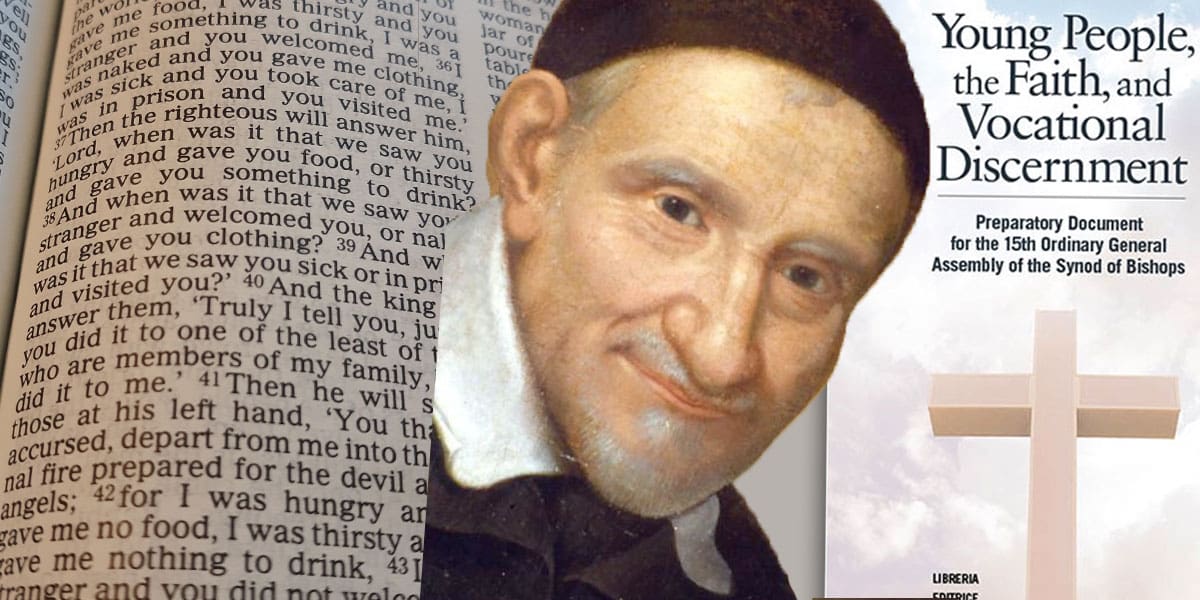Is there a Vincentian Influence on the Youth Synod?
The answer is…No.. and, very definitely, Yes!
If by influence you mean is there a member of the Vincentian Family at the Synod in Rome, the answer is I do not know of any. But there are many ways of influencing. In this sense, Vincent himself, Ozanam and his followers, are influencing not only the Synod but Pope Francis’ vision of the church.
A bold statement. Perhaps at first glance. But looking more closely there is a strong Vincentian influence of this Synod.
Let me explain
First, let’s talk about Vincent. A number of years ago I read an article that I obviously remember to this day. Rev. Emeric Amyot d’Inville, CM reflected on “To see and discern the present day challenges from the perspective of St. Vincent” In a nutshell, he pointed out that Vincent let his experience of the cases of his day to “speak” to him. He listened to those experiences in the light of the word of God. Then he asked what today we refer to as “the Vincentian Question.” Anyone recognize the watchwords of “See- Judge – and Act”?
Now despite the controversy kicked up in some circles by the preparatory document for the Vatican Synod, see – judge – act seems to me to be but another way of stating what the Youth Synod is saying is its purpose and method.
“Discernment is a truly spiritual attitude. Since it is obedience to the Spirit, discernment is listening, first and foremost, that can also become a driver for our actions, the ability to be creatively faithful to the one single mission the Church has always been entrusted with.”
In doing this it explicitly reflects “the structure of the discernment process described in Evangelii Gaudium Chapter 2″ The preparatory document for the synod calls for “recognizing, interpreting, choosing. Hence, the parts are not independent of one another, but are stages in a single overall process.”
Recognizing. The first step is to look and to listen. This requires paying attention to the real situation of today’s young people, in the diverse circumstances and contexts they live in.
Interpreting. The second step leads us to review what we have recognized, using interpretation and evaluation criteria derived from a faith perspective.
Choosing. Only in the light of a vocation that has been accepted is it possible to understand what concrete steps the Spirit is calling us to make, and what direction to follow to respond to His call.
How did we get from Vincent to the synod document?
See judge and act is deeply ingrained in the followers of Vincent and Louise. Let me in this context highlight that it was a follower of Ozanam, recently beatified Giuseppe Toniolo, who had a mostly unrecognized influence of Pope Leo XIII and Rerum Novarum” (Reflecting on New Things).
The trilogy of verbs, see, judge, act, was popularized by Father (later Cardinal) Joseph Cardijn of Belgium. He founded the Young Trade Unionists in 1919 (which became the Young Christian Workers in 1924). Although it was Cardijn who formulated the famous expression “see, judge, act” it was Léon Ollé-Laprune who was mainly responsible for developing the philosophical theory that lay behind the method.
Vatican II enshrined the approach in Church teaching with the phrase “reading the signs of the times”. See also Mt 24:33. Pope Francis walks squarely in this tradition with Evangelii Guadium.
Thus the dots are connected from the scriptures (hatsoever, you do Mt 25:35), to Vincent to the tone setting document of the Synod.
These verbs in our lives
* How often do I step back in my life to “see” (take notice of) what is happening in my life?
* Do I reflect *judge” …and pray… about what I see in the light of the gospel?
* Have I had the courage to “act’?








0 Comments